This blog post is part of a series designed to demystify the process of understanding and writing your own business rules. This post was written by Colby Germond and David Fogle.
Using variations as part of your marketplace listing strategy can facilitate a preferred marketplace experience by allowing buyers to fine-tune their product selection after they’ve located a single variation listing of interest. Variation listings include one or more attributes that each buyer can adjust to select the exact options for purchase.
It’s important to understand that marketplaces define their own requirements to support variation listings and that, once those requirements are identified and understood, Rithum’s marketplace templates must reflect those requirements.
Two channels which have fairly specific variation construct requirements are BigCommerce and Walmart Marketplace (version 3).
BigCommerce
Since sellers maintain their own individual listings within their BigCommerce webstores, Rithum’s BigCommerce template keeps the variation options very flexible. The template does not directly provide fields named “Color” or “Size”, for example; instead, sellers are responsible for providing the name of each variation option, as well as each child product’s value. To accomplish this, our template provides five groups of Option/Name and Option/Value fields in the Variant Info section.
Upon first glance, these option groups look very easy to work with. Products that vary by size will all send a name of “Size”, and then each will send its own value from the Size custom attribute. But how do we differentiate those products from products that vary by color, or products that don’t vary at all? We highly recommend ensuring that the relationship names you’ve configured within Rithum are accurate and meaningful, so that they can be referenced to create values for these fields.
Let’s use a generic apparel seller as an example. This seller will probably have a few different variation options: Size, Color, and Size/Color. Our first instinct is most likely to create rules that would act something like the following:
| Field | Strategy |
| Option 1/Name | If $RelationshipName includes “Size”, “Size”. |
| Option 1/Value | Value from Size custom attribute. |
| Option 2/Name | If $RelationshipName includes “Color”, “Color”. |
| Option 2/Value | Value from Color custom attribute. |
Unfortunately, this will not work for products that vary only by color. Each option group must be filled out in sequence, so we can’t leave the first blank and then provide values in the second. The color relationship must be available in the first group as well. We can preserve some of our original logic to accomplish this, as demonstrated in the following strategies:
| Field | Strategy |
| Option 1/Name | If $RelationshipName includes “Size”, “Size”. Otherwise, if it includes “Color”, “Color”. |
| Option 1/Value | Value from Size attribute, or default to value from Color attribute. |
| Option 2/Name | If $RelationshipName is “SizeColor”, “Color”. |
| Option 2/Value | If $RelationshipName is “SizeColor”, value from Color attribute. |
The strategies above ensure that the Color value is provided at the correct priority, and not provided twice if applicable. If you’ve been following along with this blog series, you should be able to handle converting these strategies into rules by now.
Option 1/Name:
SELECTCASE(
CONTAINS($relationshipname, “Size”), “Size”,
CONTAINS($relationshipname, “Color”), “Color”,
“”)
Option 1/Value:
IFBLANK($size, $color)
Option 1/Name:
IF($relationshipname = “SizeColor”, “Color”, “”)
Option 1/Value:
IF($relationshipname = “SizeColor”, $color, “”)
Walmart Marketplace (Version 3)
With Rithum’s recent product updates supporting Walmart Marketplace (V3) specifications, sellers should familiarize themselves with the following requirements which need to be met in order to successfully create variation style listings on Walmart Marketplace.
- The initial Rithum requirement for any products intended for variation listing at Walmart Marketplace (V3) is to ensure those products are established as a variation (in a defined parent/child relationship construct) within Rithum Inventory data (and are evident as such in the Inventory > All Products > Variations view).
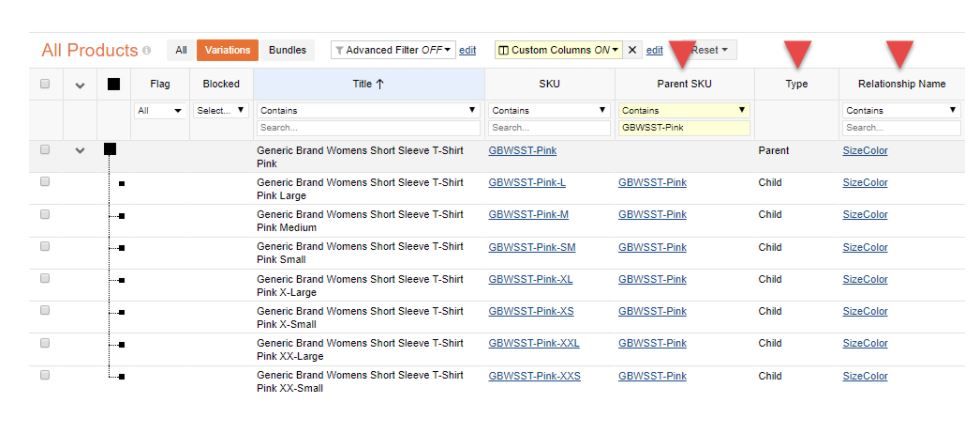

- When defining the relationship name for any product variations in Rithum, be aware that Walmart Marketplace (V3) has published specific variant attribute names per listing category in the Walmart (V3) documentation. Whether a variation product is new to Rithum, or whether its existence in the platform pre-dates the new Walmart Marketplace V3 integration, it’s important to note that the relationship name values assigned in Rithum do not need to precisely match the variant attribute naming convention defined per Walmart category.
- Once desired products are correctly established in a variation construct within Rithum Inventory, the next step is to begin populating some necessary variation product-level details.
- Generally, any products intended for listing on Walmart Marketplace (V3) must be assigned a valid Walmart subcategory value from the recently refreshed categorization guide. In order for items in a variation to publish specifically as a variation style listing, those products must share a consistent Walmart category value (either as values assigned to an attribute per product across the variation or as values resulting from identified transformational logic via a business rule and/or lookup list).
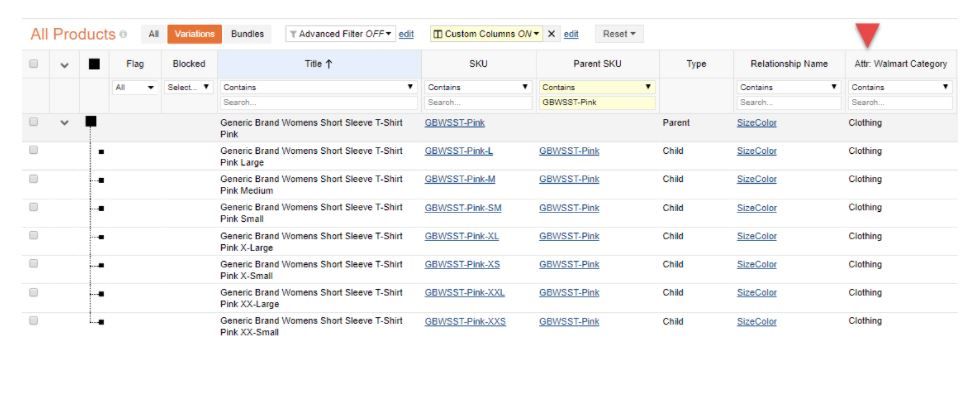

- This value will be mapped to the required Subcategory field mapping available in the Walmart Marketplace (V3) template in Rithum (Marketplaces > Walmart Marketplace > Product Mapping > Template).


- When mapping the Walmart Marketplace (V3) outbound template in Rithum, for any variation listing to succeed within the category defined, items in variation must also have populated data points to support the intended variation.
- The variation data illustrated in this blog post supports variation construct for the Walmart variant attribute names “color” and “clothingSize” in the “Clothing” Walmart Category per the following construct in Rithum:
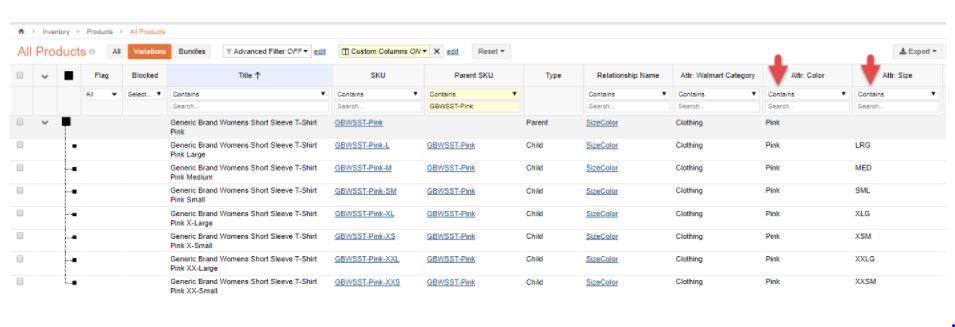

- Be sure to map all Required, Conditional and Optional fields in the Walmart Marketplace template (on both the Common tab level, and the specific Subcategory tab level) that support the requirements of the intended variation.
- Per the following illustrations, this sample variation needs mappings for Color on both the Common tab:
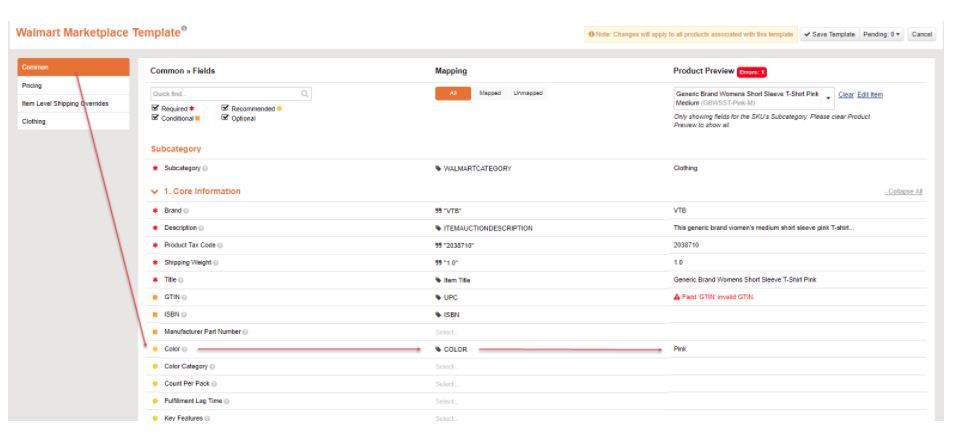

- AND Size on the “Clothing” subcategory tab:


Additionally, sellers should note the presence of the following new field mapping options associated with variation style listings at Walmart Marketplace (V3) that should also be considered:
- Is Suggested Primary Variant (Optional Mapping)
The primary variant optional mapping allows sellers to define the default child SKU item from the Rithum variation that the buyer will see when they land on the listing page at Walmart Marketplace. This child SKU should be generally representative of all of the available items within the variation listing page. If you elect to map this value in the template, ensure the child SKU item chosen to be the primary variant sends a “Yes” value for this field — you can only assign this value to one child SKU per variation construct in Rithum Inventory. It is recommended that the item is either your top-selling item within the variation OR the item with the most quantity available. If you do not elect to map this value in the template, a child SKU will be chosen at random as the primary variant.Please note: If your item belongs to a shared listing (either shared with other competing sellers of the same product or with Walmart itself), the primary variant defined may not be the primary variant that appears on the listing.


- Variant Group ID Override (Optional Mapping)
By default, Rithum is providing a unique auto-generated value to Walmart to meet this requirement on behalf of our sellers. The variant group ID override mapping functionality is only necessary to define in each instance in which the Rithum auto-generated value is not grouping the variation as desired at the marketplace. In that scenario, and in response to a properly submitted support case, Walmart will provide a variant group ID override value to be mapped in Rithum’s Walmart Marketplace template for the affected variation. The mapping can be applied as a consistent value across the variation (either as values assigned to an attribute per product across the variation or as values resulting from transformational logic via a business rule and/or lookup list).
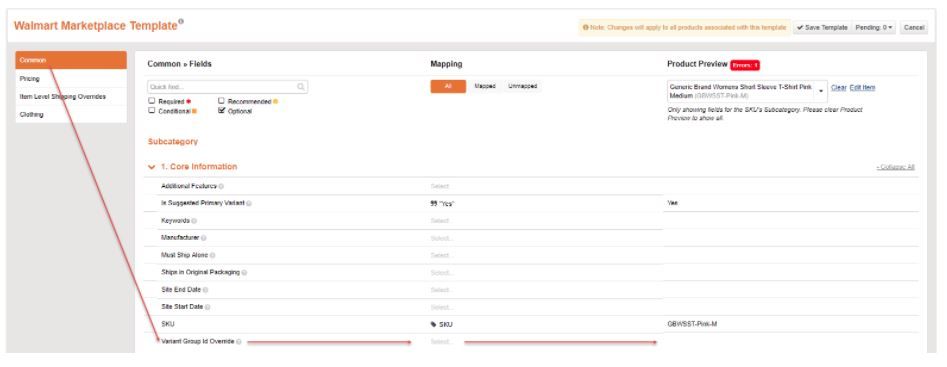

Existing Rithum sellers can find more information about the migration of Walmart Marketplace from V2 to V3 in the guide on our Community site.
If you want to learn more about business rules, feel free to explore more about business rules in the Rithum Community or check out the other posts our support team has written on business rules. If you’re struggling with a rule, you can always open a case with support to assist you.



